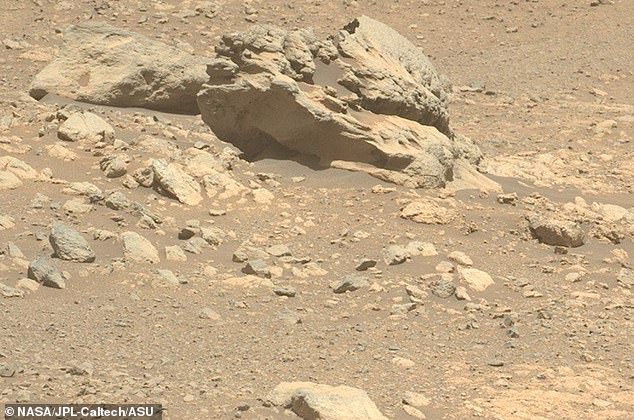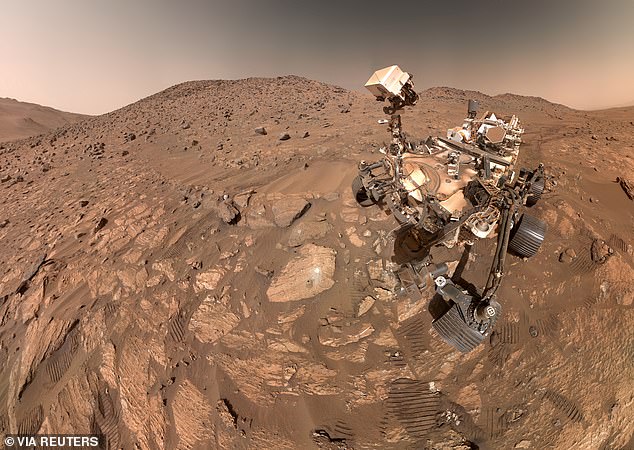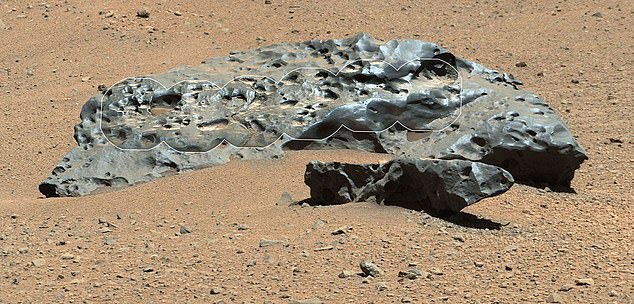NASA‘s scientists have been baffled after discovering a mysterious rock on Mars that ‘doesn’t belong there’.
The Perseverance rover found the strange rock near the rim of the 28-mile-wide (45 kilometres) Jezero crater, which scientists think could have once hosted life.
The rock, which has been named Phippsaksla, measures 31 inches (80 centimetres) across and initially stood out due to its ‘sculpted’ appearance.
Now, experts say that it likely originated from somewhere else in the solar system.
Perseverance used its SuperCam instrument to measure the rock’s composition by heating a small section of the surface with a powerful laser.
This revealed that Phippsaksla has an exceptionally high iron and nickel content.
This is unusual since Perseverance has not found a single rock with such high metal content anywhere else in Jezero crater.
Dr Candice Bedford, a geologist from Purdue University and Perseverance operator, wrote in a NASA blog: ‘This element combination is usually associated with iron-nickel meteorites formed in the core of large asteroids, suggesting that this rock formed elsewhere in the solar system.’

NASA scientists have spotted a mysterious rock on Mars which ‘shouldn’t be there’ due to its unusual metallic composition and ‘sculpted’ appearance. This image of the rock was taken using the Perseverance rover’s Mastcam-Z camera
Since landing on Mars in February 2021, Perseverance has been exploring the geology of Mars’ northern Jezero crater.
This is an area of particular interest to scientists, who believe the crater may have once been filled with water, making it one of the best places to search for signs of life.
Recently, Perseverance climbed into a region known as the Vernodden, high on the crater’s rim, where it spotted Phippsaksla.
Finding a meteor on Mars’ cratered surface isn’t unexpected, but the high metal content is much rarer.
Professor Gareth Collins, an expert on meteor impacts from Imperial College London, told Daily Mail that Mars is hit by meteors ‘all the time’.
‘At some point in time, the entire Martian surface has been shaped by impacts,’ he explained.
‘Meteors are expected on Mars on a daily basis; we don’t know the number precisely, but there should be lots each day’.
The vast majority of the meteorites falling on Mars are rocky, while only about one in 20 are rich in iron and nickel.

The rock, which has been named Phippsaksla, measures 31 inches (80 centimetres across) and has an unusually high iron and nickel content. Experts say this means it could be a meteorite which formed elsewhere in the solar system
These metallic meteorites are typically forged in the hearts of large asteroids, as the heavy minerals sank to the centre of heated rocks during the solar system’s formation.
Phippsaksla’s composition suggests that it might have had a similar origin elsewhere in the solar system, rather than forming on Mars.
Dr Gareth Dorrian, of the University of Birmingham, told Daily Mail: ‘It is quite likely this one on Mars came from the asteroid belt.
‘These particular meteorites are quite resistant to chemical weathering and are more likely to survive the fiery fall through a planetary atmosphere.’
However, despite being rarer than rocky meteorites, the sheer volume of meteorites hitting Mars means that all other Mars rovers have found iron-nickel rocks.
The Curiosity rover has found many iron-nickel meteorites in the Gale crater, including a massive 39-inch (one metre) metallic meteorite dubbed ‘Lebanon’.
Likewise, both the Curiosity and Spirit rovers found similar iron-nickel meteorites during their own missions.
Dr Bedford writes: ‘As such, it has been somewhat unexpected that Perseverance had not seen iron-nickel meteorites within Jezero crater, particularly given its similar age to Gale crater and number of smaller impact craters suggesting that meteorites did fall on the crater floor, delta, and crater rim throughout time.’

The Mars rover Perseverance (pictured) spotted the strange rock while exploring a region known as Vernodden, high on the rim of the Jezero Crater. This is a particular area of interest, since scientists think the crater may once have been filled with water

This is not the first time rovers have found iron and nickel meteorites. In 2014, the Curiosity rover found a massive 39-inch (one metre) metallic meteorite dubbed ‘Lebanon’ (pictured)

This comes after Perseverance spotted an unusual ‘helmet’ rock in the Jezero crater, which may have been formed by volcanic activity
Due to Phippsaksla’s exotic nature, NASA’s scientists say they will need more time to analyse it to confirm whether it is a meteorite.
If it is proven that the rock fell from space, then Perseverance can finally be ranked among the rovers to have investigated these rare and fascinating Martian visitors.
However, this is not the first unusual discovery that Perseverance has made on its journey through the Jezero crater.
In August, Perseverance snapped a picture of a bizarre ‘helmet’ on the Martian surface.
A closer look reveals it was covered from top to bottom with small bobbles, which are known by geologists as ‘spherules’.
On Earth, spherules are formed by the rapid cooling of molten rock droplets during a volcanic eruption, or by the condensation of rock vaporised by a meteorite impact.
This suggests it might have been formed some time in the distant past when Mars’ surface was dotted with active volcanoes.

